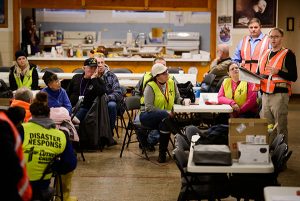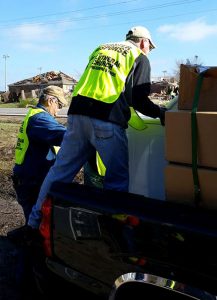By Roger Drinnon
Relief efforts following the late-December tornadoes in North Texas and flooding in the Midwest underscore the importance of training local responders ahead of time — and LCMS Disaster Response is here to help.

“There is an enormous need to have groups that are trained before a disaster strikes,” said the Rev. Ross Johnson, the LCMS Office of National Mission’s Disaster Response director. “You never know when a tragedy is going to happen, and there’s nothing more helpful when a tragedy happens than to have people trained and ready to go in at a moment’s notice.”
One of the ways in which the Synod enables LCMS districts and congregations to respond to crises is by building up their local response capacity through early training available year-round through LCMS Disaster Response.
“We offer a one-day course for LERT — Lutheran Early Response Team training — which is a 6- to 7-hour event normally done on a Saturday, and it focuses on what to do and what not to do when disaster strikes,” said Johnson. “Having trained disaster-response teams in place helps form a network of responders ready to go and makes it easier to [rapidly] deploy additional volunteers for disaster recovery.”
He said those who complete the training are formally certified as LERT members, and they receive badges allowing them access to certain controlled areas where relief and recovery operations are conducted in the aftermath of a natural disaster.
Johnson said districts can plan LERT training events where LCMS Disaster Response helps them become self-sufficient, adding that the best responders are those who are trained and who live near the affected area, since this allows for the most rapid initial response. He said the Synod also certifies LERT trainers at the district and congregation level. “Train the trainer” courses are normally provided for District Disaster Response Coordinators (DDRCs) and other people they identify to be qualified, said Johnson.
Value of LERT training
“LERT training certification is very helpful in that the character of initial and long-term response to disasters is outlined, providing a sound framework for the most helpful activities leading to recovery,” said the Rev. Steven Misch, DDRC for the Texas District.
Johnson said Misch and David Ricks, chairman of the Disaster Care Ministry for Beautiful Savior Lutheran Church in Arlington, Texas, were instrumental in the recovery efforts after 10 tornadoes ripped through the Dallas-Fort Worth area Dec. 26. (See a related story, “Preparedness, training aid in recovery in aftermath of Texas tornadoes.”)
Johnson said the response in Texas exemplifies how LERT training can pay off in unexpected times of need.
“LERT training is an integral part of what we do,” said Ricks, also a certified LERT trainer. “Through LERT training, we have formed a relationship with a number of churches in the region. We are able to mobilize volunteers quickly and make an impact. Our LERT training helps us focus on disaster response as a ministry. The focus of sharing God’s mercy sets our ministry apart from other organizations.”

Johnson also praised the Synod’s Central Illinois District (CID), which holds as many as eight LERT training events a year. CID- and Northern Illinois District-trained responders have been helping communities within the CID that were flooded following severe rainstorms across the Midwest. The CID has 400 certified team members, including more than 60 certified LERT chainsaw members.
“Chainsaw training is available for members of congregations who are already LERT trained, at the congregation’s request, for those congregations in regions prone to tornadoes, hurricanes and other severe storms,” said Johnson. “This helps a lot with cleanup operations and debris removal following a natural disaster.”
Johnson said LCMS Disaster Response also assists districts and congregations in getting critical equipment needed to safely perform recovery work.
“We’re also able to help responders with the gear needed to do hands-on recovery operations — generators, power washers, tools, wheelbarrows — all the stuff needed for a smooth, effective response to help the affected communities when a disaster happens,” he said. “This year alone, we’re giving out dozens of grants, so congregations and districts have the necessary equipment.”
Johnson said LCMS Disaster Response also has partnered with the Lutheran Women’s Missionary League to provide disaster-response trailer grants. Disaster-response trailers house essential equipment and resources needed for disaster-relief operations and to provide Gospel comfort to churches and communities suffering in the wake of disasters. Grant applications are available at lcms.org/disaster/forms.
Simple qualifications
He said any LCMS Lutheran over 18 can be a valuable LERT member, including those with physical limitations.
“The only requirement is that LERT members must be LCMS Lutherans and at least 18 years old. There is no maximum age limitation,” said Johnson. “Not all work is physically demanding — teams also need members who can prepare meals, organize equipment and supplies, and people to organize human-care and spiritual-care committees to follow up with disaster victims by visiting them once the disaster recovery subsides.”
Johnson said having more trained responders strengthens the Synod’s network to provide body-and-soul care for all those suffering in the aftermath of catastrophes like the recent floods and tornadoes.
“This is how we are able to help not only LCMS Lutherans but also entire communities affected by natural disasters,” said Johnson.
For more information on LCMS Disaster Response, visit lcms.org/disaster.
Roger Drinnon (roger.drinnon@lcms.org) is manager of Editorial Services for LCMS Communications.
Posted Jan. 21, 2016




